Early Childhood Education and Care: Exploring Cultural Contexts Report
VerifiedAdded on 2020/03/16
|11
|2450
|359
Report
AI Summary
This report delves into the cultural dimensions of early childhood education and care, primarily within the context of New Zealand. It examines the concepts of Kete, Whakapapa, and Tikanga, which are integral to Maori culture and their influence on early learning. The report analyzes the significance of Te Whariki, the early childhood curriculum framework in New Zealand, and its bicultural approach. It explores how Te Whariki provides guidelines for educational institutes and emphasizes the importance of incorporating Maori language and culture into early learning environments. Annotated bibliographies are included to support the understanding of the cultural context and practical applications of the curriculum. The report highlights the importance of creating inclusive environments where children from diverse backgrounds, including Afghan families, can thrive and learn. The report also includes references to relevant articles and resources, further enriching the understanding of the subject matter.
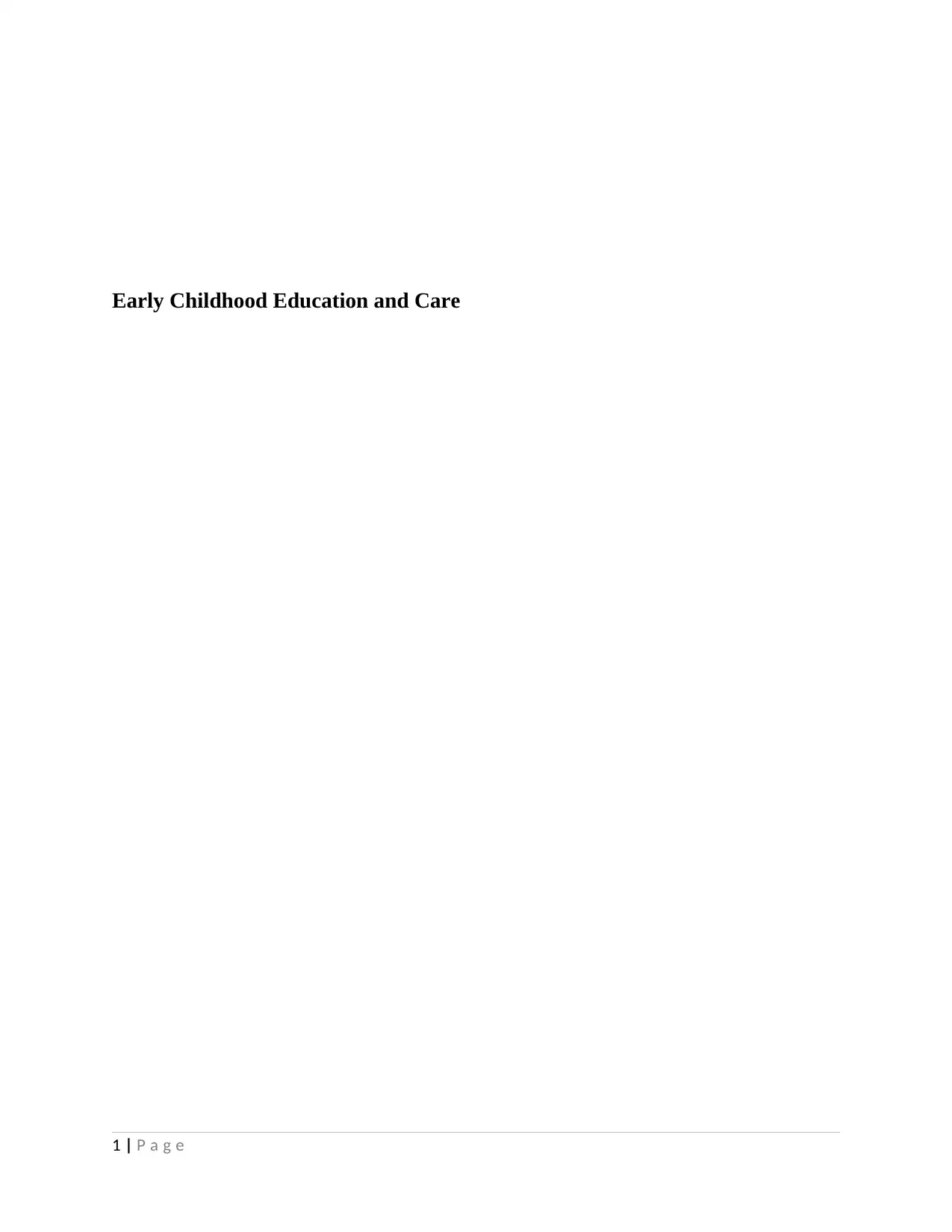
Early Childhood Education and Care
1 | P a g e
1 | P a g e
Paraphrase This Document
Need a fresh take? Get an instant paraphrase of this document with our AI Paraphraser
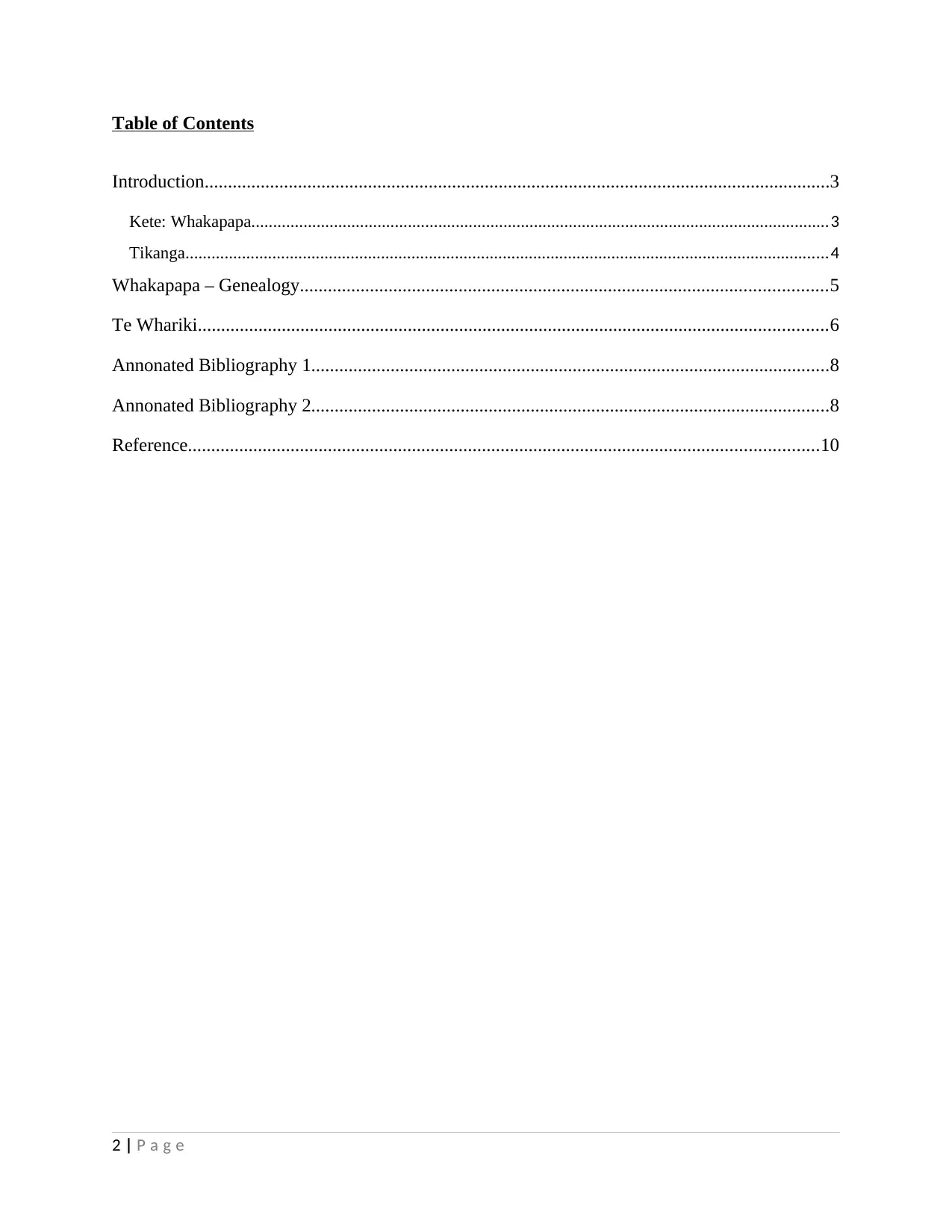
Table of Contents
Introduction......................................................................................................................................3
Kete: Whakapapa.....................................................................................................................................3
Tikanga....................................................................................................................................................4
Whakapapa – Genealogy.................................................................................................................5
Te Whariki.......................................................................................................................................6
Annonated Bibliography 1...............................................................................................................8
Annonated Bibliography 2...............................................................................................................8
Reference.......................................................................................................................................10
2 | P a g e
Introduction......................................................................................................................................3
Kete: Whakapapa.....................................................................................................................................3
Tikanga....................................................................................................................................................4
Whakapapa – Genealogy.................................................................................................................5
Te Whariki.......................................................................................................................................6
Annonated Bibliography 1...............................................................................................................8
Annonated Bibliography 2...............................................................................................................8
Reference.......................................................................................................................................10
2 | P a g e
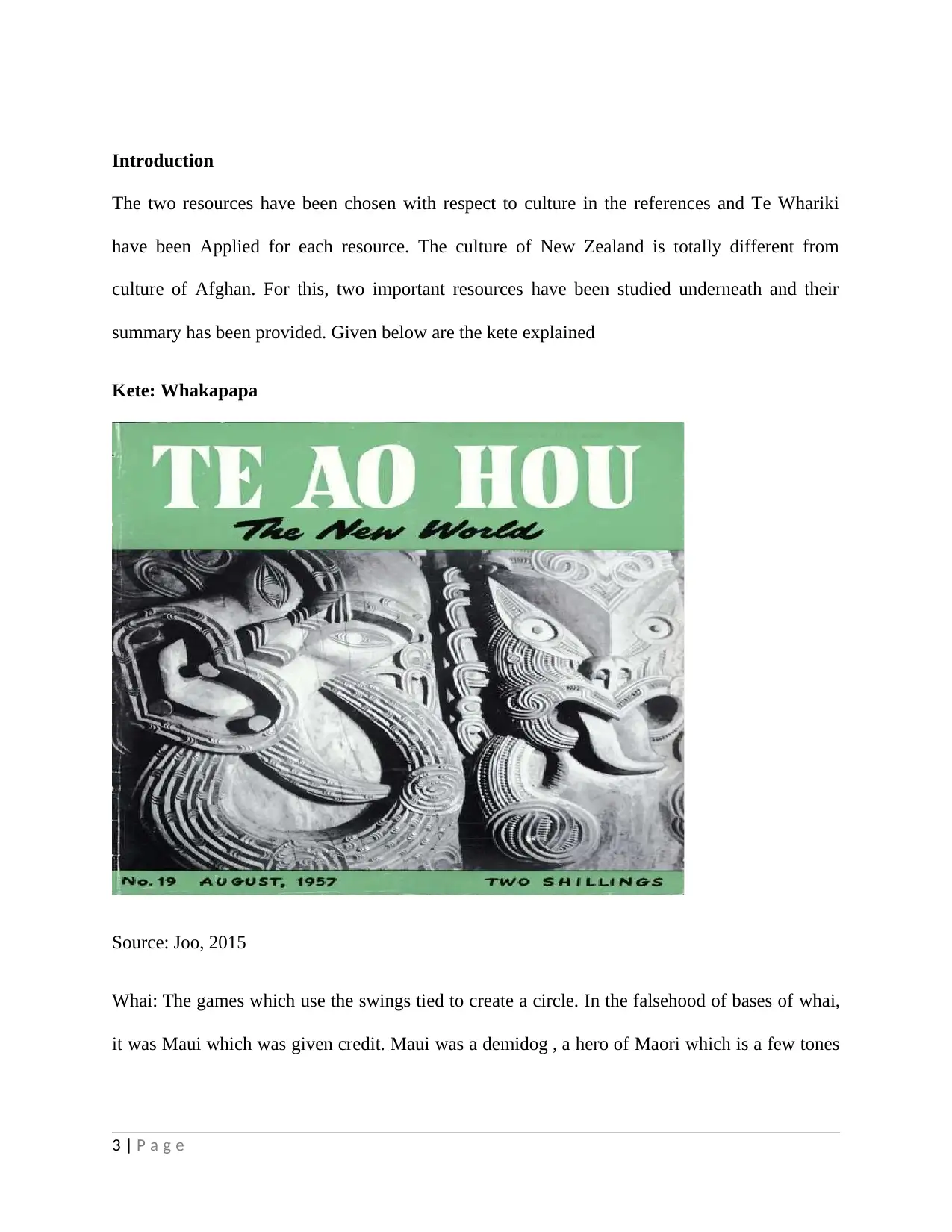
Introduction
The two resources have been chosen with respect to culture in the references and Te Whariki
have been Applied for each resource. The culture of New Zealand is totally different from
culture of Afghan. For this, two important resources have been studied underneath and their
summary has been provided. Given below are the kete explained
Kete: Whakapapa
Source: Joo, 2015
Whai: The games which use the swings tied to create a circle. In the falsehood of bases of whai,
it was Maui which was given credit. Maui was a demidog , a hero of Maori which is a few tones
3 | P a g e
The two resources have been chosen with respect to culture in the references and Te Whariki
have been Applied for each resource. The culture of New Zealand is totally different from
culture of Afghan. For this, two important resources have been studied underneath and their
summary has been provided. Given below are the kete explained
Kete: Whakapapa
Source: Joo, 2015
Whai: The games which use the swings tied to create a circle. In the falsehood of bases of whai,
it was Maui which was given credit. Maui was a demidog , a hero of Maori which is a few tones
3 | P a g e
⊘ This is a preview!⊘
Do you want full access?
Subscribe today to unlock all pages.

Trusted by 1+ million students worldwide

recognised by its name. When this string is put on the hand and pulled with fingers and thumbs
there is a rectangular loop created in such a pattern is known as whai.
The word whakapapa is taken from the term papa which means levels of our lives. Therefore it
denotes different genealogical layers and Lines of dissent which make the personal identification
and connect to the families that is whanau, hapaus (sub-tribes) and iwi (tribes) (Webb, 2013).
Te ao kori (the world of movement) is a Māori festivity of life by progress and its lots of
languages. all through the past, Māori have created traditions to sharpen psychological and
physical agility, hand-eye harmonization, and a wisdom of comfort. The surroundings has
encouraged a wide variety of actions, pastimes, competitions, dance, song, entertainments, and
gratification – a festivity of life. The acts might be stimulating and demanding or quiet and
thoughtful to reconcile the spirit. They comprise individual and group acts, verbal
communication, tikanga, and cultural appearance. Te ao kori is the uniting idea that can hold all
characteristics of personality – personality, relatives, ethnic, regional, and nationwide.
Te ao kori has a lot of cultural expressions sole to Aotearoa New Zealand and has advantages for
the nation in the twenty-first century – that its citizens can all discover to value, benefit, and
understand these features that usually set them unique in the world (whariki, 2017).
Whakapapa – Genealogy
Whakapapa is to place a age group over the other. Consequently the ones who are alive are the
only eyes and ears of those departed prior to them (precedent). As one live his day to day life
(present) he looks forward to maintain and give feasible possibilities for his upcoming
generations. Whakapapa can be clarified as ‘to move in the direction of Papa’, Papa being the
whenua, and the earth being the mother, as she makes people stay, and grounds them ‘who they
4 | P a g e
there is a rectangular loop created in such a pattern is known as whai.
The word whakapapa is taken from the term papa which means levels of our lives. Therefore it
denotes different genealogical layers and Lines of dissent which make the personal identification
and connect to the families that is whanau, hapaus (sub-tribes) and iwi (tribes) (Webb, 2013).
Te ao kori (the world of movement) is a Māori festivity of life by progress and its lots of
languages. all through the past, Māori have created traditions to sharpen psychological and
physical agility, hand-eye harmonization, and a wisdom of comfort. The surroundings has
encouraged a wide variety of actions, pastimes, competitions, dance, song, entertainments, and
gratification – a festivity of life. The acts might be stimulating and demanding or quiet and
thoughtful to reconcile the spirit. They comprise individual and group acts, verbal
communication, tikanga, and cultural appearance. Te ao kori is the uniting idea that can hold all
characteristics of personality – personality, relatives, ethnic, regional, and nationwide.
Te ao kori has a lot of cultural expressions sole to Aotearoa New Zealand and has advantages for
the nation in the twenty-first century – that its citizens can all discover to value, benefit, and
understand these features that usually set them unique in the world (whariki, 2017).
Whakapapa – Genealogy
Whakapapa is to place a age group over the other. Consequently the ones who are alive are the
only eyes and ears of those departed prior to them (precedent). As one live his day to day life
(present) he looks forward to maintain and give feasible possibilities for his upcoming
generations. Whakapapa can be clarified as ‘to move in the direction of Papa’, Papa being the
whenua, and the earth being the mother, as she makes people stay, and grounds them ‘who they
4 | P a g e
Paraphrase This Document
Need a fresh take? Get an instant paraphrase of this document with our AI Paraphraser
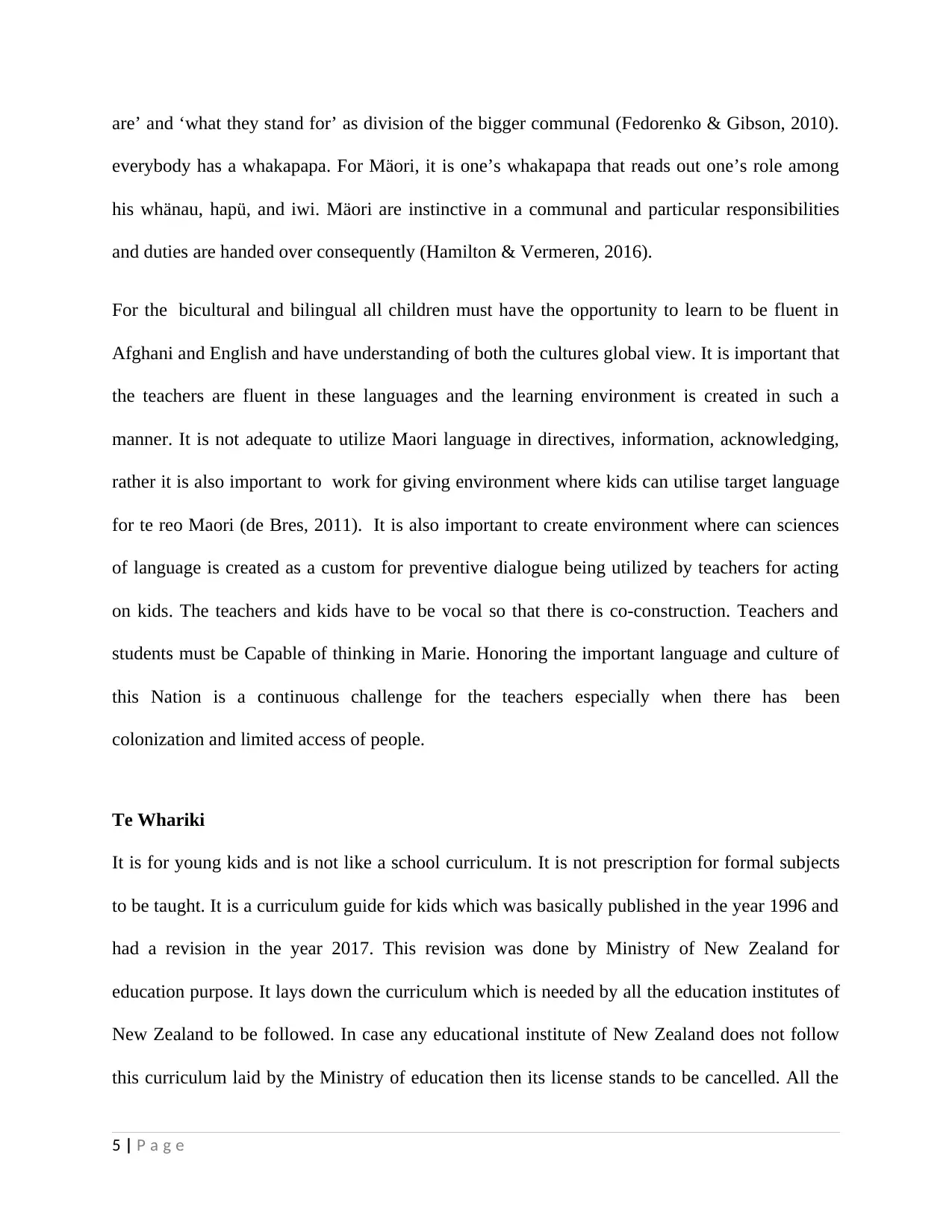
are’ and ‘what they stand for’ as division of the bigger communal (Fedorenko & Gibson, 2010).
everybody has a whakapapa. For Mäori, it is one’s whakapapa that reads out one’s role among
his whänau, hapü, and iwi. Mäori are instinctive in a communal and particular responsibilities
and duties are handed over consequently (Hamilton & Vermeren, 2016).
For the bicultural and bilingual all children must have the opportunity to learn to be fluent in
Afghani and English and have understanding of both the cultures global view. It is important that
the teachers are fluent in these languages and the learning environment is created in such a
manner. It is not adequate to utilize Maori language in directives, information, acknowledging,
rather it is also important to work for giving environment where kids can utilise target language
for te reo Maori (de Bres, 2011). It is also important to create environment where can sciences
of language is created as a custom for preventive dialogue being utilized by teachers for acting
on kids. The teachers and kids have to be vocal so that there is co-construction. Teachers and
students must be Capable of thinking in Marie. Honoring the important language and culture of
this Nation is a continuous challenge for the teachers especially when there has been
colonization and limited access of people.
Te Whariki
It is for young kids and is not like a school curriculum. It is not prescription for formal subjects
to be taught. It is a curriculum guide for kids which was basically published in the year 1996 and
had a revision in the year 2017. This revision was done by Ministry of New Zealand for
education purpose. It lays down the curriculum which is needed by all the education institutes of
New Zealand to be followed. In case any educational institute of New Zealand does not follow
this curriculum laid by the Ministry of education then its license stands to be cancelled. All the
5 | P a g e
everybody has a whakapapa. For Mäori, it is one’s whakapapa that reads out one’s role among
his whänau, hapü, and iwi. Mäori are instinctive in a communal and particular responsibilities
and duties are handed over consequently (Hamilton & Vermeren, 2016).
For the bicultural and bilingual all children must have the opportunity to learn to be fluent in
Afghani and English and have understanding of both the cultures global view. It is important that
the teachers are fluent in these languages and the learning environment is created in such a
manner. It is not adequate to utilize Maori language in directives, information, acknowledging,
rather it is also important to work for giving environment where kids can utilise target language
for te reo Maori (de Bres, 2011). It is also important to create environment where can sciences
of language is created as a custom for preventive dialogue being utilized by teachers for acting
on kids. The teachers and kids have to be vocal so that there is co-construction. Teachers and
students must be Capable of thinking in Marie. Honoring the important language and culture of
this Nation is a continuous challenge for the teachers especially when there has been
colonization and limited access of people.
Te Whariki
It is for young kids and is not like a school curriculum. It is not prescription for formal subjects
to be taught. It is a curriculum guide for kids which was basically published in the year 1996 and
had a revision in the year 2017. This revision was done by Ministry of New Zealand for
education purpose. It lays down the curriculum which is needed by all the education institutes of
New Zealand to be followed. In case any educational institute of New Zealand does not follow
this curriculum laid by the Ministry of education then its license stands to be cancelled. All the
5 | P a g e
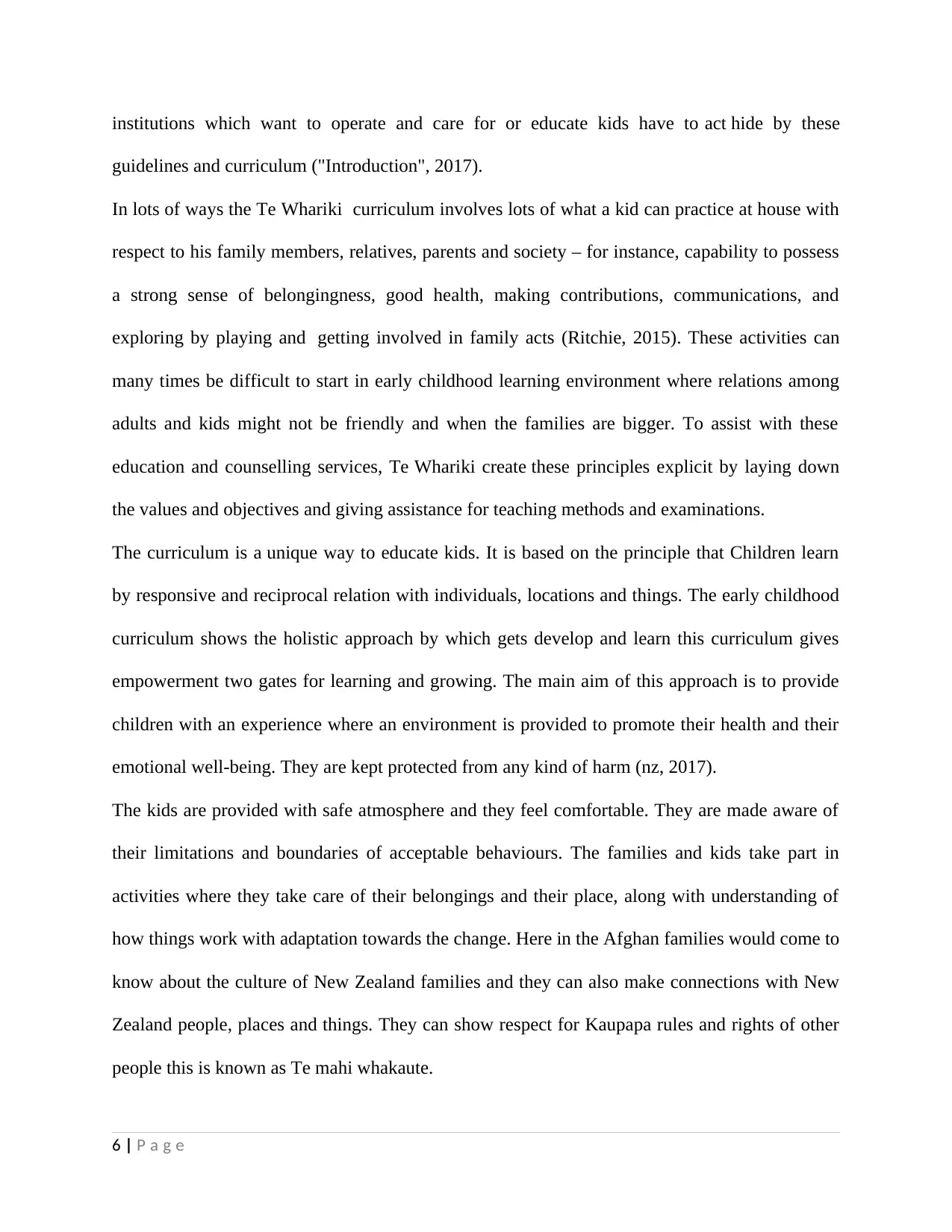
institutions which want to operate and care for or educate kids have to act hide by these
guidelines and curriculum ("Introduction", 2017).
In lots of ways the Te Whariki curriculum involves lots of what a kid can practice at house with
respect to his family members, relatives, parents and society – for instance, capability to possess
a strong sense of belongingness, good health, making contributions, communications, and
exploring by playing and getting involved in family acts (Ritchie, 2015). These activities can
many times be difficult to start in early childhood learning environment where relations among
adults and kids might not be friendly and when the families are bigger. To assist with these
education and counselling services, Te Whariki create these principles explicit by laying down
the values and objectives and giving assistance for teaching methods and examinations.
The curriculum is a unique way to educate kids. It is based on the principle that Children learn
by responsive and reciprocal relation with individuals, locations and things. The early childhood
curriculum shows the holistic approach by which gets develop and learn this curriculum gives
empowerment two gates for learning and growing. The main aim of this approach is to provide
children with an experience where an environment is provided to promote their health and their
emotional well-being. They are kept protected from any kind of harm (nz, 2017).
The kids are provided with safe atmosphere and they feel comfortable. They are made aware of
their limitations and boundaries of acceptable behaviours. The families and kids take part in
activities where they take care of their belongings and their place, along with understanding of
how things work with adaptation towards the change. Here in the Afghan families would come to
know about the culture of New Zealand families and they can also make connections with New
Zealand people, places and things. They can show respect for Kaupapa rules and rights of other
people this is known as Te mahi whakaute.
6 | P a g e
guidelines and curriculum ("Introduction", 2017).
In lots of ways the Te Whariki curriculum involves lots of what a kid can practice at house with
respect to his family members, relatives, parents and society – for instance, capability to possess
a strong sense of belongingness, good health, making contributions, communications, and
exploring by playing and getting involved in family acts (Ritchie, 2015). These activities can
many times be difficult to start in early childhood learning environment where relations among
adults and kids might not be friendly and when the families are bigger. To assist with these
education and counselling services, Te Whariki create these principles explicit by laying down
the values and objectives and giving assistance for teaching methods and examinations.
The curriculum is a unique way to educate kids. It is based on the principle that Children learn
by responsive and reciprocal relation with individuals, locations and things. The early childhood
curriculum shows the holistic approach by which gets develop and learn this curriculum gives
empowerment two gates for learning and growing. The main aim of this approach is to provide
children with an experience where an environment is provided to promote their health and their
emotional well-being. They are kept protected from any kind of harm (nz, 2017).
The kids are provided with safe atmosphere and they feel comfortable. They are made aware of
their limitations and boundaries of acceptable behaviours. The families and kids take part in
activities where they take care of their belongings and their place, along with understanding of
how things work with adaptation towards the change. Here in the Afghan families would come to
know about the culture of New Zealand families and they can also make connections with New
Zealand people, places and things. They can show respect for Kaupapa rules and rights of other
people this is known as Te mahi whakaute.
6 | P a g e
⊘ This is a preview!⊘
Do you want full access?
Subscribe today to unlock all pages.

Trusted by 1+ million students worldwide
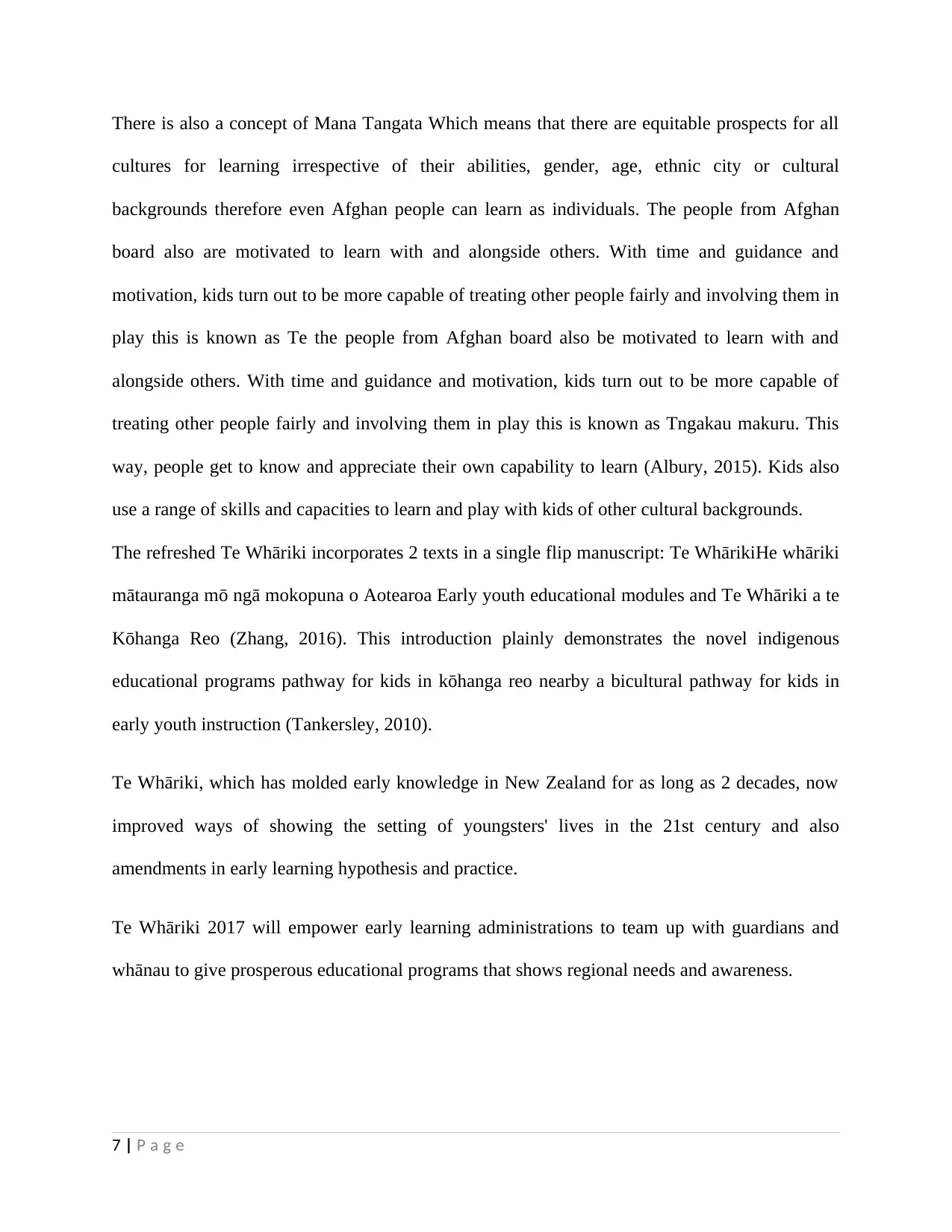
There is also a concept of Mana Tangata Which means that there are equitable prospects for all
cultures for learning irrespective of their abilities, gender, age, ethnic city or cultural
backgrounds therefore even Afghan people can learn as individuals. The people from Afghan
board also are motivated to learn with and alongside others. With time and guidance and
motivation, kids turn out to be more capable of treating other people fairly and involving them in
play this is known as Te the people from Afghan board also be motivated to learn with and
alongside others. With time and guidance and motivation, kids turn out to be more capable of
treating other people fairly and involving them in play this is known as Tngakau makuru. This
way, people get to know and appreciate their own capability to learn (Albury, 2015). Kids also
use a range of skills and capacities to learn and play with kids of other cultural backgrounds.
The refreshed Te Whāriki incorporates 2 texts in a single flip manuscript: Te WhārikiHe whāriki
mātauranga mō ngā mokopuna o Aotearoa Early youth educational modules and Te Whāriki a te
Kōhanga Reo (Zhang, 2016). This introduction plainly demonstrates the novel indigenous
educational programs pathway for kids in kōhanga reo nearby a bicultural pathway for kids in
early youth instruction (Tankersley, 2010).
Te Whāriki, which has molded early knowledge in New Zealand for as long as 2 decades, now
improved ways of showing the setting of youngsters' lives in the 21st century and also
amendments in early learning hypothesis and practice.
Te Whāriki 2017 will empower early learning administrations to team up with guardians and
whānau to give prosperous educational programs that shows regional needs and awareness.
7 | P a g e
cultures for learning irrespective of their abilities, gender, age, ethnic city or cultural
backgrounds therefore even Afghan people can learn as individuals. The people from Afghan
board also are motivated to learn with and alongside others. With time and guidance and
motivation, kids turn out to be more capable of treating other people fairly and involving them in
play this is known as Te the people from Afghan board also be motivated to learn with and
alongside others. With time and guidance and motivation, kids turn out to be more capable of
treating other people fairly and involving them in play this is known as Tngakau makuru. This
way, people get to know and appreciate their own capability to learn (Albury, 2015). Kids also
use a range of skills and capacities to learn and play with kids of other cultural backgrounds.
The refreshed Te Whāriki incorporates 2 texts in a single flip manuscript: Te WhārikiHe whāriki
mātauranga mō ngā mokopuna o Aotearoa Early youth educational modules and Te Whāriki a te
Kōhanga Reo (Zhang, 2016). This introduction plainly demonstrates the novel indigenous
educational programs pathway for kids in kōhanga reo nearby a bicultural pathway for kids in
early youth instruction (Tankersley, 2010).
Te Whāriki, which has molded early knowledge in New Zealand for as long as 2 decades, now
improved ways of showing the setting of youngsters' lives in the 21st century and also
amendments in early learning hypothesis and practice.
Te Whāriki 2017 will empower early learning administrations to team up with guardians and
whānau to give prosperous educational programs that shows regional needs and awareness.
7 | P a g e
Paraphrase This Document
Need a fresh take? Get an instant paraphrase of this document with our AI Paraphraser

Annonated Bibliography 1
The topic of Whakapapa – Genealogy has been taken from the link: http://health.tki.org.nz/Key-
collections/Exploring-te-ao-kori/Learning-experiences/String-games, showing how teachers and
educators need to be well versed in the Maori language in terms of directives, information,
acknowledging. This is important for them to teach the kids with the Maori and Non-Maori
background. This way, the kids get exposure to both the cultures’ background ("String games /
Learning experiences / Exploring te ao kori / Key collections / Home - Health & PE", 2017).
In New Zealand there is a culture of Tikanga- where the students work in pairs to support each
other in learning in this kind of string act. This kind of learning motivates group activity and
students help each other to attain a particular strength pattern (Fedorenko & Gibson, 2010). This
kind of learning can be a teacher resisted or peer supported or the students can also learn via
images or experiments. There are different vocabulary is also, for example the parish or patterns
are known ngatauira heketau , games and past times are known as nga mahi a te Rehia etc .
Annonated Bibliography 2
Te Whariki Te Whāriki (Ministry of Education, 1996), had been the first bicultural teaching set
of courses in Aotearoa, reasserted a promise previously extensively recognized all over the NZ
for the early childhood education segment, to Te Tiriti o Waitangi , and the rationale and
enclosure of te reo me ōna tikanga as an incorporated constituent of early childhood tutoring
programs. Te Whāriki has well-built apparent statements of prospects for instructors with respect
to ratifying te reo Māori in their teaching (Zealand, 2017).
Whereas the general formation of standards, filaments and objectives of Te Whāriki continue as
before, Te Whāriki now has less learning results – lessened from 118 to 20 - and connects early
8 | P a g e
The topic of Whakapapa – Genealogy has been taken from the link: http://health.tki.org.nz/Key-
collections/Exploring-te-ao-kori/Learning-experiences/String-games, showing how teachers and
educators need to be well versed in the Maori language in terms of directives, information,
acknowledging. This is important for them to teach the kids with the Maori and Non-Maori
background. This way, the kids get exposure to both the cultures’ background ("String games /
Learning experiences / Exploring te ao kori / Key collections / Home - Health & PE", 2017).
In New Zealand there is a culture of Tikanga- where the students work in pairs to support each
other in learning in this kind of string act. This kind of learning motivates group activity and
students help each other to attain a particular strength pattern (Fedorenko & Gibson, 2010). This
kind of learning can be a teacher resisted or peer supported or the students can also learn via
images or experiments. There are different vocabulary is also, for example the parish or patterns
are known ngatauira heketau , games and past times are known as nga mahi a te Rehia etc .
Annonated Bibliography 2
Te Whariki Te Whāriki (Ministry of Education, 1996), had been the first bicultural teaching set
of courses in Aotearoa, reasserted a promise previously extensively recognized all over the NZ
for the early childhood education segment, to Te Tiriti o Waitangi , and the rationale and
enclosure of te reo me ōna tikanga as an incorporated constituent of early childhood tutoring
programs. Te Whāriki has well-built apparent statements of prospects for instructors with respect
to ratifying te reo Māori in their teaching (Zealand, 2017).
Whereas the general formation of standards, filaments and objectives of Te Whāriki continue as
before, Te Whāriki now has less learning results – lessened from 118 to 20 - and connects early
8 | P a g e
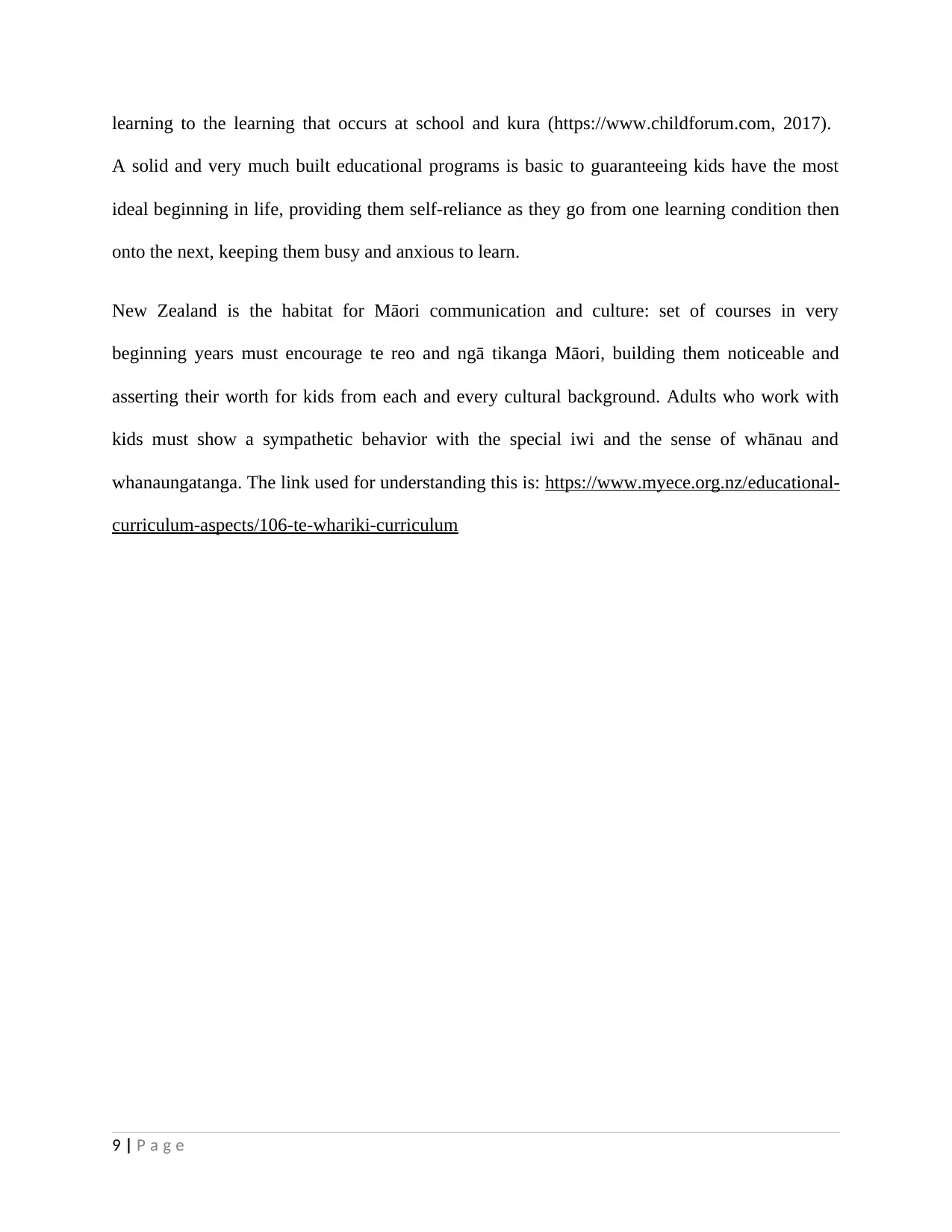
learning to the learning that occurs at school and kura (https://www.childforum.com, 2017).
A solid and very much built educational programs is basic to guaranteeing kids have the most
ideal beginning in life, providing them self-reliance as they go from one learning condition then
onto the next, keeping them busy and anxious to learn.
New Zealand is the habitat for Māori communication and culture: set of courses in very
beginning years must encourage te reo and ngā tikanga Māori, building them noticeable and
asserting their worth for kids from each and every cultural background. Adults who work with
kids must show a sympathetic behavior with the special iwi and the sense of whānau and
whanaungatanga. The link used for understanding this is: https://www.myece.org.nz/educational-
curriculum-aspects/106-te-whariki-curriculum
9 | P a g e
A solid and very much built educational programs is basic to guaranteeing kids have the most
ideal beginning in life, providing them self-reliance as they go from one learning condition then
onto the next, keeping them busy and anxious to learn.
New Zealand is the habitat for Māori communication and culture: set of courses in very
beginning years must encourage te reo and ngā tikanga Māori, building them noticeable and
asserting their worth for kids from each and every cultural background. Adults who work with
kids must show a sympathetic behavior with the special iwi and the sense of whānau and
whanaungatanga. The link used for understanding this is: https://www.myece.org.nz/educational-
curriculum-aspects/106-te-whariki-curriculum
9 | P a g e
⊘ This is a preview!⊘
Do you want full access?
Subscribe today to unlock all pages.

Trusted by 1+ million students worldwide
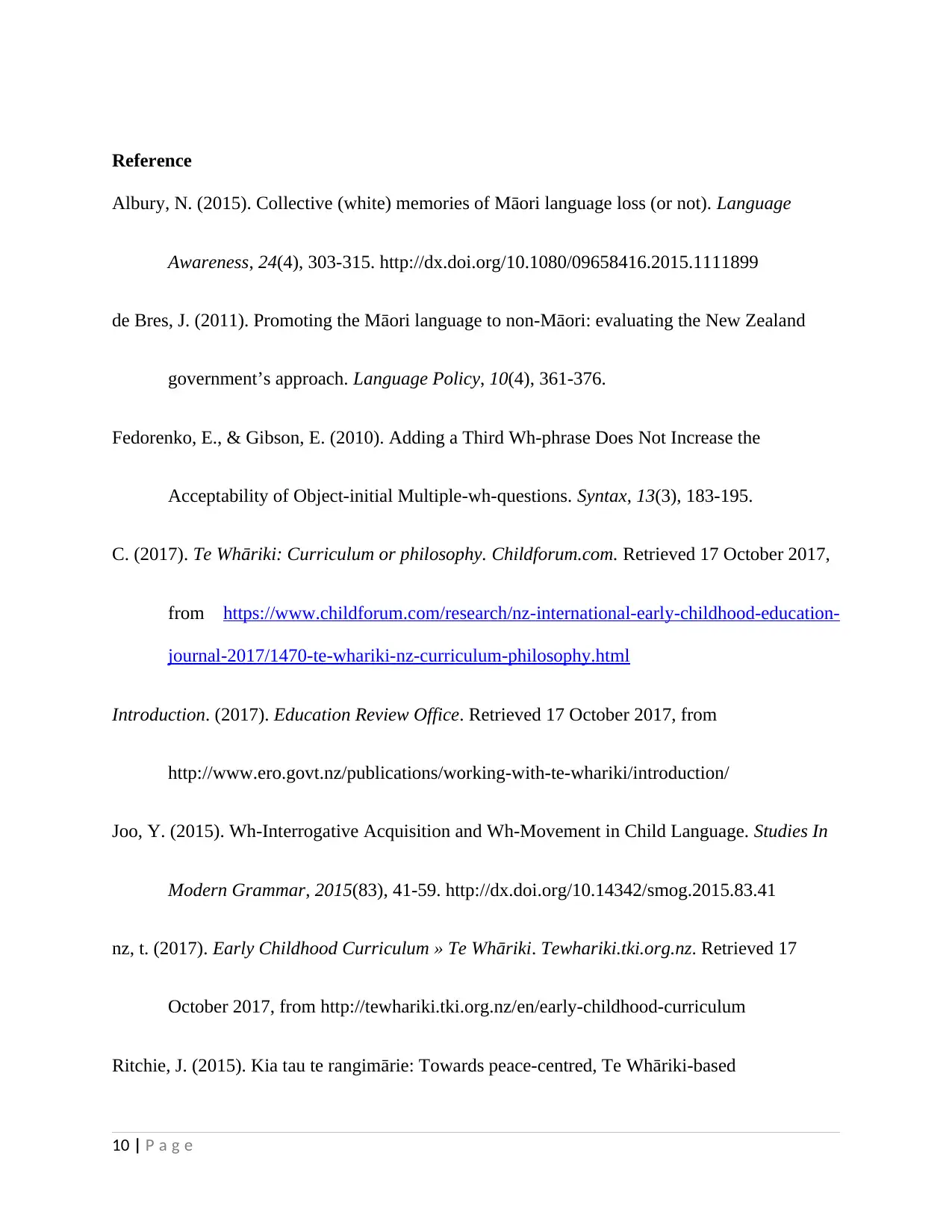
Reference
Albury, N. (2015). Collective (white) memories of Māori language loss (or not). Language
Awareness, 24(4), 303-315. http://dx.doi.org/10.1080/09658416.2015.1111899
de Bres, J. (2011). Promoting the Māori language to non-Māori: evaluating the New Zealand
government’s approach. Language Policy, 10(4), 361-376.
Fedorenko, E., & Gibson, E. (2010). Adding a Third Wh-phrase Does Not Increase the
Acceptability of Object-initial Multiple-wh-questions. Syntax, 13(3), 183-195.
C. (2017). Te Whāriki: Curriculum or philosophy. Childforum.com. Retrieved 17 October 2017,
from https://www.childforum.com/research/nz-international-early-childhood-education-
journal-2017/1470-te-whariki-nz-curriculum-philosophy.html
Introduction. (2017). Education Review Office. Retrieved 17 October 2017, from
http://www.ero.govt.nz/publications/working-with-te-whariki/introduction/
Joo, Y. (2015). Wh-Interrogative Acquisition and Wh-Movement in Child Language. Studies In
Modern Grammar, 2015(83), 41-59. http://dx.doi.org/10.14342/smog.2015.83.41
nz, t. (2017). Early Childhood Curriculum » Te Whāriki. Tewhariki.tki.org.nz. Retrieved 17
October 2017, from http://tewhariki.tki.org.nz/en/early-childhood-curriculum
Ritchie, J. (2015). Kia tau te rangimārie: Towards peace-centred, Te Whāriki-based
10 | P a g e
Albury, N. (2015). Collective (white) memories of Māori language loss (or not). Language
Awareness, 24(4), 303-315. http://dx.doi.org/10.1080/09658416.2015.1111899
de Bres, J. (2011). Promoting the Māori language to non-Māori: evaluating the New Zealand
government’s approach. Language Policy, 10(4), 361-376.
Fedorenko, E., & Gibson, E. (2010). Adding a Third Wh-phrase Does Not Increase the
Acceptability of Object-initial Multiple-wh-questions. Syntax, 13(3), 183-195.
C. (2017). Te Whāriki: Curriculum or philosophy. Childforum.com. Retrieved 17 October 2017,
from https://www.childforum.com/research/nz-international-early-childhood-education-
journal-2017/1470-te-whariki-nz-curriculum-philosophy.html
Introduction. (2017). Education Review Office. Retrieved 17 October 2017, from
http://www.ero.govt.nz/publications/working-with-te-whariki/introduction/
Joo, Y. (2015). Wh-Interrogative Acquisition and Wh-Movement in Child Language. Studies In
Modern Grammar, 2015(83), 41-59. http://dx.doi.org/10.14342/smog.2015.83.41
nz, t. (2017). Early Childhood Curriculum » Te Whāriki. Tewhariki.tki.org.nz. Retrieved 17
October 2017, from http://tewhariki.tki.org.nz/en/early-childhood-curriculum
Ritchie, J. (2015). Kia tau te rangimārie: Towards peace-centred, Te Whāriki-based
10 | P a g e
Paraphrase This Document
Need a fresh take? Get an instant paraphrase of this document with our AI Paraphraser
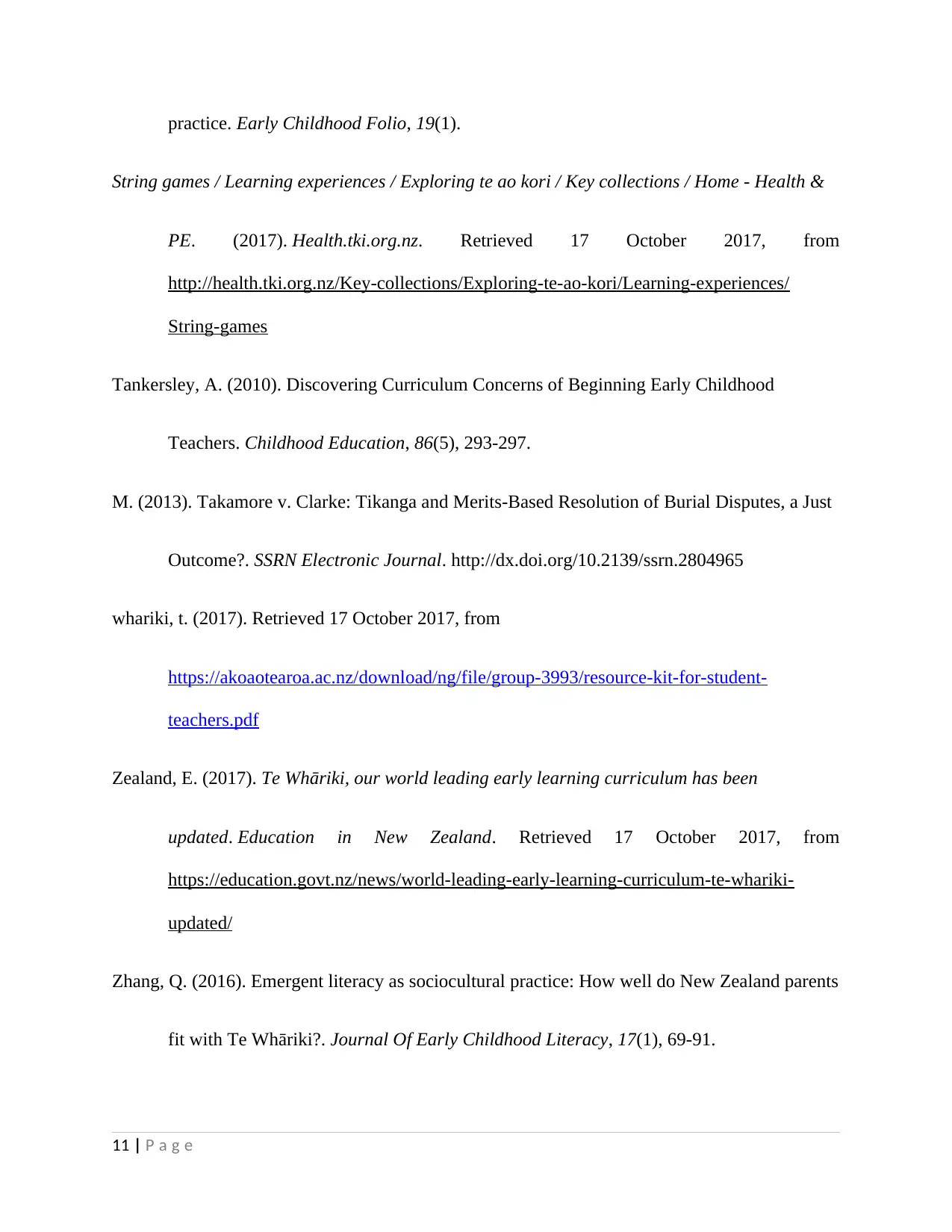
practice. Early Childhood Folio, 19(1).
String games / Learning experiences / Exploring te ao kori / Key collections / Home - Health &
PE. (2017). Health.tki.org.nz. Retrieved 17 October 2017, from
http://health.tki.org.nz/Key-collections/Exploring-te-ao-kori/Learning-experiences/
String-games
Tankersley, A. (2010). Discovering Curriculum Concerns of Beginning Early Childhood
Teachers. Childhood Education, 86(5), 293-297.
M. (2013). Takamore v. Clarke: Tikanga and Merits-Based Resolution of Burial Disputes, a Just
Outcome?. SSRN Electronic Journal. http://dx.doi.org/10.2139/ssrn.2804965
whariki, t. (2017). Retrieved 17 October 2017, from
https://akoaotearoa.ac.nz/download/ng/file/group-3993/resource-kit-for-student-
teachers.pdf
Zealand, E. (2017). Te Whāriki, our world leading early learning curriculum has been
updated. Education in New Zealand. Retrieved 17 October 2017, from
https://education.govt.nz/news/world-leading-early-learning-curriculum-te-whariki-
updated/
Zhang, Q. (2016). Emergent literacy as sociocultural practice: How well do New Zealand parents
fit with Te Whāriki?. Journal Of Early Childhood Literacy, 17(1), 69-91.
11 | P a g e
String games / Learning experiences / Exploring te ao kori / Key collections / Home - Health &
PE. (2017). Health.tki.org.nz. Retrieved 17 October 2017, from
http://health.tki.org.nz/Key-collections/Exploring-te-ao-kori/Learning-experiences/
String-games
Tankersley, A. (2010). Discovering Curriculum Concerns of Beginning Early Childhood
Teachers. Childhood Education, 86(5), 293-297.
M. (2013). Takamore v. Clarke: Tikanga and Merits-Based Resolution of Burial Disputes, a Just
Outcome?. SSRN Electronic Journal. http://dx.doi.org/10.2139/ssrn.2804965
whariki, t. (2017). Retrieved 17 October 2017, from
https://akoaotearoa.ac.nz/download/ng/file/group-3993/resource-kit-for-student-
teachers.pdf
Zealand, E. (2017). Te Whāriki, our world leading early learning curriculum has been
updated. Education in New Zealand. Retrieved 17 October 2017, from
https://education.govt.nz/news/world-leading-early-learning-curriculum-te-whariki-
updated/
Zhang, Q. (2016). Emergent literacy as sociocultural practice: How well do New Zealand parents
fit with Te Whāriki?. Journal Of Early Childhood Literacy, 17(1), 69-91.
11 | P a g e
1 out of 11
Your All-in-One AI-Powered Toolkit for Academic Success.
+13062052269
info@desklib.com
Available 24*7 on WhatsApp / Email
![[object Object]](/_next/static/media/star-bottom.7253800d.svg)
Unlock your academic potential
Copyright © 2020–2025 A2Z Services. All Rights Reserved. Developed and managed by ZUCOL.